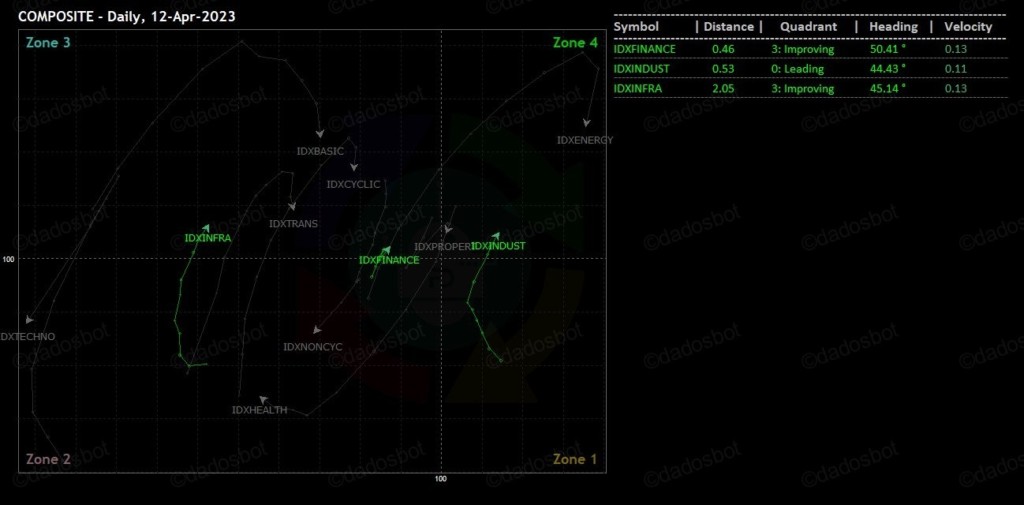Daily Analysis 20230413

April 13th, 2023
Good morning,
Stocks ended Wednesday’s regular trading session on a down note. The S&P 500
closed 0.41% lower, while the Nasdaq Composite
dropped 0.85%. The Dow snapped a four-day winning streak, ending the day down 38.29 points, or 0.11%.
At the first, the major averages were earlier in the session following the release of March’s consumer price index report, which showed headline pressures slowed last month. The CPI advanced 0.1% month over month in March, and 5% from the prior year.
Traders’ sentiment turned in the afternoon after the release of minutes from the March Federal Open Market Committee meeting. In particular, the Fed expects the recent banking crisis to cause a recession later this year.
Dow……33647 -38.3 -0.11%
Nasdaq11929 -102.5 -0.85%
S&P 500.4092 -16.99 -0.41%
FTSE…..7825 +39.1 +0.50%
Dax……15704 +48.4 +0.31%
CAC……7397 +6.7 +0.09%
Nikkei…..28083 +159.3 +0.57%
HSI………20310 -175.4 -0.86%
Shanghai.3327 +13.6 +0.41%
IDX…..6798.96 -12.35 -0.18%
LQ45….943.18 +1.40 +0.15%
IDX30…491.46 +0.62 +0.13%
IDXEnergy…2052.28 -33.74 -1.62%
IDX BscMat 1158.66 -3.28 -0.28%
IDX Indstrl…1204.13 +11.57 +0.97%
IDXNONCYC.712.94 -3.69 -0.51%
IDX Hlthcare1505.43 -8.02 -0.53%
IDXCYCLIC…..810.57 -1.42 -0.18%
IDX Techno..4817.76 -71.02 -1.45%
IDX Transp..1779.01 +6.01 +0.34%
IDX Infrast…..803.45 +0.94 +0.12%
IDX Finance.1391.44 +2.65 +0.19%
IDX Banking.1145.74 +4.32 +0.38%
IDX Property…694 -2.0 -0.28%
Indo10Yr.6.7472+0.0047+0.07%
ICBI….354.8340+0.0088+0.00%
US2Yr.3.9682 -0.0647 -1.60%
US5Yr 3.4659 -0.0690 -1.95%
US10Yr3.4000 -0.0320 -0.93%
US30Yr.3.6350+0.010 +0.28%
VIX…… 19.09 -0.01 -0.05%
USDIndx101.5000 -0.6530 -0.64%👍
Como Indx.275.73 +1.00 +0.37%
(Core Commodity CRB)
BCOMIN…156.52 +1.82 +1.17%
IndoCDS..92.110 +0.4900 +0.53%
(5-yr INOCD5) (11/04)
IDR…..14880.00👍 -5.50 -0.04%
Jisdor.14866.00👍 -22.00 -0.15%
Euro……1.0994 +0.0080 +0.73%
TLKM….28.90 +0.05 +0.17%
(4297)
EIDO……23.90 +0.05 +0.17%
EEM……39.39 -0.28 -0.71%
Oil……83.26 +1.73 +2.12%
Gold.2024.90 +5.70 +0.28%
Timah..24308.00 – -%
(Closed 06/04)
Nickel..23565.00 +491.00 +2.13%
(Closed 11/04)
Silver……25.46 +0.27 +1.08%
Copper…408.10 +6.15 +1.53%
Nturl Gas.2.084 -0.1760 -7.91%‼️
Ammonia 3633.33 – -%
China
(Domestic Price)(10/04)
Coal price.194.60 -0.55 -0.28%
(Apr/Newcastle)
Coal price.202.40 -2.60 -1.26%
(May/Newcastle)
Coal price.205.90 +1.40 +0.68%
(Jun/Newcastle)
Coal price.206.05 -2.10 -1.00%
(Jul/Newcastle)
Coal price.133.80 +4.35 +3.36%‼️
(Apr/Rotterdam)
Coal price.126.95 +0.95 +0.75%
(May/ Rotterdam)
Coal price 125.35 +0.35 +0.28%
(Jun/Rotterdam)
Coal price 125.75 -0.10 -0.08%
(Jul/Rotterdam)
CPO(Jun)…3775 -120 -3.08%‼️
(Source: bursamalaysia.com)
Corn……..627.75 +0.00 +0.00%
SoybeanOil54.16 -0.85 -1.55%
Wheat…..679.60 +5.50 +0.82%
Wood pulp..4740.00 -50.00 -1.05%
(Closed 11/04)
©️Phintraco Sekuritas
Broker Code: AT
Desy Erawati/ DE
Source: Bloomberg, Investing, IBPA, CNBC, Bursa Malaysia
Copyright: Phintraco Sekuritas
US merah, europe ijo, asia varied, US dollar index turun, yang consequently means semua commodity yang diikat nilai nya ke dollar cenderung naik. Index mungkin akan sideways tapi saham terkait komoditi harusnya tetep jalan
Oil up, gas drop, coal newcastle down, coal rotterdam jump, cpo drop. Ini sih keliatannya giliran ANTM MDKA INCO TINS untuk jalan lagi
IHSG – stoch masih down, macdp, 833 almostbuy, MFI up, BD flat, FNB,w% flat, retracement pattern keliatan mau bawa naik after mantul di fibo 23, masih optimis double bottom jalan
Kemarin BUMN konstruksi semua digoreng, Infrastructure jadi keliatan jalan, selain JSMR yang sudah run duluan. Industrials ASII kemarin naik tinggi, BMTR semoga nyusul, Financials BBCA BBRI BMRI kemaren jalan,semoga lanjut biar bisa ngangkat index, repot gendong GOTO yang bikin rusak aja
Stochastic Buy Signal: ASII PGAS MTEL MTMH MIKA LMSH WINS
MACD Buy Signal: INTP ADHI MTMH PTPP TKIM ANJT






